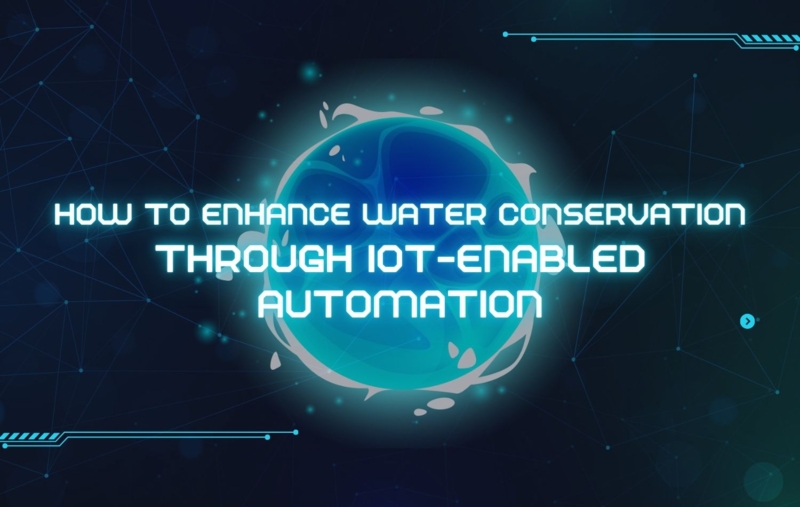How To Enhance Water Conservation Through IoT-Enabled Automation
Published on by Shibani Thakur, waterapp2021@gmail.com in Technology
Climate change, city growth, and industry needs are depleting water faster than it can be replaced. Technology is helping people globally save water and become more sustainable. Adding technology to the Water Level Indicator through the Internet of Things (IoT) is one of the most exciting new ideas. IoT is turning old water-saving methods into smart, responsive networks that make use more efficient and stop waste. Examples include smart watering and finding leaks.

The Role of IoT in Modern Water Management
IoT is a network of devices with sensors, software, and connectivity that share and act on data. IoT devices may detect leaks, track water use, and send water based on real-time demands to save water.
Traditional systems require human input and predefined plans, but IoT-enabled automation makes decisions based on real-time data. This method greatly lowers the chance of mistakes, stops overuse, and adjusts to environmental changes, making water management better and more long-lasting.
Smart Irrigation Systems
Smart irrigation systems in farming and gardening are one of the most important ways IoT Water Technology can help save water. Soil moisture monitors, weather data, and evapotranspiration rates are used by these systems to figure out when and how much water to give out.
Smart irrigation systems don't use set watering times. Instead, they only water plants when they need it. The device can delay or skip irrigation if soil moisture sensors indicate enough moisture or rain is anticipated. Water is saved, plants grow better, and expenditures are minimized with this accuracy.
In cities, these kinds of devices are now widely used in green infrastructure projects, public parks, and golf courses. They help cities meet their water efficiency goals.
Water Leak Detection and Prevention
Water distribution networks leak billions of gallons of waste annually. Home, business, and city water systems can leak. Traditional methods of discovering leaks entail hand or reactive inspection, so problems are only repaired after harm is observed.
IoT-enabled sensors that find leaks are a proactive option. Pipe sensors continuously measure pressure, flow, and sound waves. The IoT Water Technology can immediately notify the repair team of unusual patterns, such as sudden pressure drops or flow during off-hours.
AI-driven data can detect problems before they happen, facilitating maintenance in advanced systems. This saves water and reduces the time and money needed to fix things.
Real-Time Water Usage Monitoring
Real-time water usage data for households, businesses, and industries is needed to encourage conservation. IoT Water Level Indicator provide detailed water use, location, and quantity data.
These smart meters can detect issues like fixtures using more water than intended or unusual usage. Mobile apps and dashboards let property owners establish use limits, get alerts, and remotely turn off the water supply in an emergency.
This data helps utility providers estimate demand, manage supply during peak times, and create better water-saving measures based on user behaviour.
Rainwater Harvesting Automation
Collecting rainwater is a good way to save water, but many old systems aren't smart enough to make the best use of the water they store. IoT monitors can turn these systems into smart water harvesting systems that monitor tank levels, rainfall forecasts, and water usage.
For example, if the Water Level Indicator senses that a storm is coming, the system can release or shift extra water ahead of time to ensure that the tanks have enough space to hold new rain. Additionally, collected water can be sent immediately to systems for irrigation, flushing, or cleaning based on set rules and the amount of water available at the moment. This ensures that the water is used as efficiently as possible with as little human input as possible.
Industrial and Municipal Water Management
Some of the biggest users of water are businesses and cities. IoT-powered Water Technology benefits these settings on both the big and small scales. With their thousands of sensors, smart water grids can track water flow across the whole network, find inefficiencies, and ensure fair sharing.
IoT is often combined with factory Supervisory Control and Data Acquisition (SCADA) systems to monitor real-time chemical dosing, water quality, and reuse amounts. By automating tasks like refilling cooling towers or treating garbage, factories not only save water but also meet government rules and make operations run more smoothly.
Taxonomy
- Water Management
- Water networks, Leakage management & detection, Qualified EQA, IQA and Assessor
- Supercritical water technology